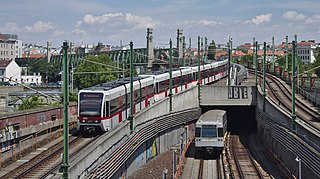
The Vienna U-Bahn, where U-Bahn is an abbreviation of the German word Untergrundbahn, is a rapid transit system serving Vienna, Austria. The five-line network consists of 83.1 kilometers (51.6 mi) of route, serving 109 stations. It is the backbone of what the International Association of Public Transport (UITP) deemed one of the best-performing public transport systems worldwide in 2009. 459.8 million passengers rode the U-Bahn in 2019. The network is undergoing expansion and rolling stock renewal. Since 1969, 200 million euros have been invested annually in the extension of the Vienna U-Bahn.

A tram-train is a type of light rail vehicle that both meets the standards of a light rail system, and also national mainline standards. Tramcars are adapted to be capable of running on streets like an urban tramway but also be permitted operation alongside mainline trains. This allows services that can utilise both existing urban light rail systems and mainline railway networks and stations. It combines the urban accessibility of a tram or light rail with a mainline train's greater speed in the suburbs.
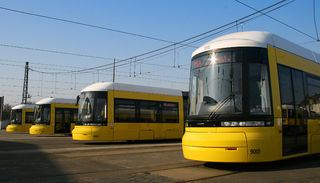
The Berlin tramway is the main tram system in Berlin, Germany. It is one of the oldest tram networks in the world having its origins in 1865 and is operated by Berliner Verkehrsbetriebe (BVG), which was founded in 1929. It is notable for being the third-largest tram system in the world, after Melbourne and St. Petersburg. Berlin's tram system is made up of 22 lines that operate across a standard gauge network, with almost 800 stops and measuring almost 190 kilometres (120 mi) in route length and 430 kilometres (270 mi) in line length. Nine of the lines, called Metrotram, operate 24 hours a day and are identified with the letter "M" before their number; the other thirteen lines are regular city tram lines and are identified by just a line number.

Trams make an important contribution to public transport in the city of Zürich in Switzerland. The tram network serves most city neighbourhoods, and is the backbone of public transport within the city, albeit supplemented by the inner sections of the Zürich S-Bahn, along with urban trolleybus and bus routes, as well as two funicular railways, one rack railway and passenger boat lines on the river and on the lake. The trams and other city transport modes operate within a fare regime provided by the cantonal public transport authority Zürcher Verkehrsverbund (ZVV), which also covers regional rail and bus services.
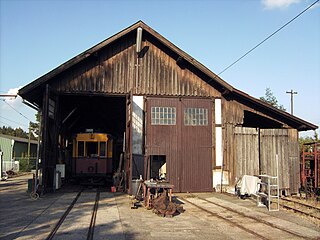
The Florianerbahn is a museum tramway in Upper Austria that is not operational due to construction work. It was built as a railway - a licensed narrow gauge Lokalbahn or branch line - between the independent commununity of Ebelsberg and Sankt Florian. It was owned by the Lokalbahn Ebelsberg–St. Florian AG, but operated by the firm of Stern & Hafferl from Gmunden. Because the line had the character of a tramway (Überlandstraßenbahn) it switched over to providing tramway services in the wake of the annexation of Austria in 1938 – along with Stern & Hafferl's sister companies Elektrische Lokalbahn Unterach–See and Elektrische Lokalbahn Gmunden.

The U3 is an underground line in Nuremberg. The line was opened on 14 June 2008. It is about 9.2 kilometres (5.7 mi) long, making it the shortest in the system. The number of stations is 14. The termini are Nordwestring and Großreuth. U 3 trains are run driverless and have been since the opening of the line. U3 shares part of its route with the older U2. Due to the circuitous horseshoe-shaped route, U3 is not always the fastest public transit option between its stations. For example, the buses that run along B4R are - per the official schedules - faster for getting from Nordwestring to Gustav Adolf Straße and the tramway line 4 is faster for getting from Friedrich Ebert Platz to Plärrer than the respective U3 connection.

The Munich tramway is the tramway network for the city of Munich in Germany. Today it is operated by the municipally owned Münchner Verkehrsgesellschaft and is known officially and colloquially as the Tram. Previous operators have included Société Anonyme des Tramways de Munich, the Münchner Trambahn-Aktiengesellschaft, the Städtische Straßenbahnen and the Straßenbahn München.

Trams in Vienna are a vital part of the public transport system in Vienna, capital city of Austria. In operation since 1865, with the completion of a 2 km (1.2 mi) route to industrial estates near Simmering, it reached its maximum extent of 292 km (181.4 mi) in 1942. In February 2015, it was the fifth largest tram network in the world, at about 176.9 kilometres (109.9 mi) in total length and 1,071 stations.

The Potsdam tramway network is a network of tramways forming part of the public transport system in Potsdam, the capital city of the federal state of Brandenburg, Germany.

The Graz tramway network is a network of tramways forming an important part of the public transport system in Graz, which is both the capital city of the federal state of Styria, Austria, and the second largest city in Austria.

The Nuremberg tramway network is a network of tramways forming part of the public transport system in Nuremberg, a city in the federal state of Bavaria, Germany. The system reached the neighboring city of Fürth from its opening year to almost a century later when construction of the U1 subway line led to the withdrawal of tram service to and within Fürth. During that era and referring to it historically in literature or nostalgic activities, the system was known as “Nürnberg-Fürther Straßenbahn“. For example, a local association dedicated to preserving the history and heritage of the tram network as well as old rolling stock calls itself “Freunde der Nürnberg-Fürther Straßenbahn“ The system is planned to cross the municipal boundaries of Nuremberg once more, if and when the extension to Erlangen and from there to Herzogenaurach dubbed "Stadtumlandbahn" opens.
Stern & Hafferl Verkehrsgesellschaft m.b.H. is a transport company operating train, bus and boat services in Upper Austria, Austria. The company operates 80 km (50 mi) of standard gauge railway and 31 km (19 mi) of narrow gauge railway. Until December 2009 Stern & Hafferl operated the route from Lambach to Haag, but this line has been closed. They carry 4.7 million passengers per year and 150,000 tonnes of freight.

The Traunseebahn is a historic railway in Austria, running from Vorchdorf to Gmunden.

The Winterthur tramway network was part of the public transport network of the city of Winterthur, in the canton of Zürich, Switzerland, for more than 50 years.
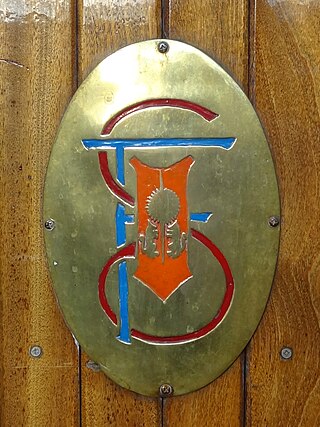
The Tranvía de Sóller is a Spanish heritage tramway serving the town of Sóller and the coastal village of Port de Sóller, in the island of Majorca. It is owned by Ferrocarril de Sóller S.A. (FS), the same company operating the heritage rail line linking the town to the city of Palma.

Trams in Linz is a network of tramways forming the backbone of the urban public transport system in Linz, which is the capital city of the federal state of Upper Austria in Austria.

The Essen Stadtbahn is a 19.6-kilometer (12.2 mi) light rail (Stadtbahn) network in Essen and the two neighbouring towns of Mülheim an der Ruhr and Gelsenkirchen in the German state of North Rhine Westphalia. It forms part of the Rhine-Ruhr Stadtbahn.

The Bonn tramway network forms part of the public transport system in the city Bonn, North Rhine-Westphalia, Germany, along with the Bonn Stadtbahn with which the tramlines are heavily integrated. The tram network consists of three tram lines which makes Bonn's tramway relatively small, as it comprises only 29.52 kilometres (18.34 mi) of route. The tramway is operated by 24 low-floor tramcars.
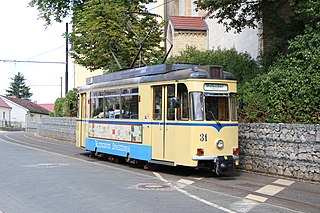
The Woltersdorf Tramway is a standard gauge tramway, located in Woltersdorf, Brandenburg, near Berlin, Germany. The line is notable for its use of historic vehicles, using 4 wheeled trams, built in the early 1960s. The line was constructed in 1913, to connect Woltersdorf to the Berlin Suburban railways. It is one of the smallest tram operators in Germany, and has not expanded beyond its 1913 route.
The Vienna semi-metro tramway system was built on separated sections in the 1960s. The underground sections are called Untergrundstrassenbahn or sometimes abbreviated U-Strassenbahn, USTRAB or USTRABA . The semi-metro tunnels are maintained and used by the Wiener Linien, operator of the tramway lines. One section is used as well by the Wiener Lokalbahnen (WLB), the operator of a regional tram-train service.

























